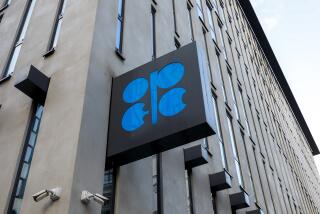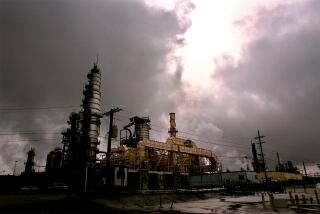OPEC Oil Output Up in August, Agency Says
BRUSSELS — OPEC nations opened their oil taps a bit more in August to boost their crude production to one of the highest levels so far this year, according to estimates released Tuesday.
The International Energy Agency said in its monthly oil market report that the Organization of Petroleum Exporting Countries pumped about 21.6 million barrels of oil a day last month--up 200,000 barrels from a revised July figure of 21.4 million and 2.6 million barrels a day higher than last year.
The IEA estimate also is about 2 million barrels more than the 19.5-million-barrel ceiling set by OPEC when it met in June.
Other sources have put OPEC’s August production at between 21.5 million and 21.7 million barrels. Petroleum Intelligence Weekly, a respected trade newsletter, estimated OPEC’s July output at 21.8 million barrels.
Too much oil last year led to a price drop of more than $5 in West Texas Intermediate, the benchmark U.S. crude, from $18.52 on April 18, 1988, to the year’s low of $12.60 on Oct. 5. While higher demand has kept prices from falling as dramatically this year, prices have weakened, and analysts say they could continue to do so before they recover.
$18-a-Barrel Target
By October, consumers could see a slight decline in retail gasoline prices--about 2 to 3 cents a gallon, said William Veno, director of oil market analysis for Data Resources Inc.
“The majority of the higher output came from Iran, which had experienced a decline in July,” the IEA report said.
The 13 OPEC nations agreed in June to try to keep output under control and prices near a target of $18 a barrel. But despite the promises, the cartel’s supply has remained strong, depressing prices from their highs of last spring.
The average price of a basket of the seven OPEC-monitored crudes registered $16.44 a barrel at the end of August, compared to $18 last spring.
Prices for West Texas Intermediate have been running in the range of $18 to $19 a barrel, but other U.S. crudes have been weaker. The benchmark crude, which a growing number of analysts say does not represent the market, had been up to $24 a barrel in April.
Paul Mlotok, head of energy research at Morgan Stanley & Co. in New York, said OPEC’s production seems to have stabilized. “They’ve kind of found their level and the market is pretty much absorbing it,” he said.
Higher demand this year--about 1 million barrels a day more--is one reason prices haven’t fallen further, Veno said.
May Raise Supply Cap
Moreover, lower U.S. production and oil rig accidents in the North Sea and elsewhere have lowered world oil output and enabled OPEC to pump more oil without serious repercussions, Veno said.
“In order for them not to undermine prices further and precipitate a collapse, OPEC will have to hold production at about 21.6 million barrels,” Veno said. While fourth-quarter demand is expected to grow, North Sea and other non-OPEC production also is expected to grow as repairs are completed, he said.
An OPEC monitoring panel will meet in Geneva on Sept. 23 to analyze the market and decide whether to raise the supply cap to around 20 million barrels a day in the last quarter of the year.
The United Arab Emirates produced 1.8 million barrels a day in August, well above its OPEC-set ceiling of about 1 million barrels, the IEA reported.
Kuwait’s output last month was estimated at 1.6 million barrels a day, up from its target of 1 million barrels.
Nigeria pumped about 1.8 million barrels a day last month, higher than its 1.4-million-barrel quota.
Saudi Arabia, the world’s largest oil exporter, produced 4.8 million barrels a day, about the same as its target.
Iran and Iraq both pumped at their quota levels of 2.8 million barrels a day, according to the report.
The report noted that Iraq was nearing completion of a pipeline through Saudi Arabia that would increase its capacity to export oil to about 3 million barrels a day.
The output of other cartel members in August was at or near their targets:
Indonesia, 1.2 million barrels a day; Venezuela, 1.7 million barrels; Algeria, 700,000 barrels; Ecuador, 300,000 barrels; Libya, 1.1 million barrels; Qatar, 400,000 barrels, and Gabon, 200,000 barrels.
The Paris-based IEA is an arm of the Organization for Economic Cooperation and Development, made up of Western nations, including the United States, Japan, France, Britain and West Germany.
More to Read
Inside the business of entertainment
The Wide Shot brings you news, analysis and insights on everything from streaming wars to production — and what it all means for the future.
You may occasionally receive promotional content from the Los Angeles Times.










